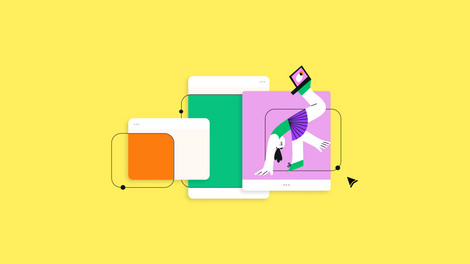Every click, view, and emotion can be quantified and analyzed in marketing.
The data gathered from these interactions provide vital insights into the behavior and interests of customers. Marketers can then create personalized, automated workflows to target prospects more effectively and nurture them through the sales funnel.
Automation doesn't mean diminishing the human touch or creative freedom. It can elevate your craft to a new level by having repetitive, manual tasks done for you.
Intrigued? Let's look at marketing automation and learn how to leverage it in your processes and workflows.
Jumpstart your ideas with Linearity Curve
Take your designs to the next level.
What's marketing automation?
Marketing automation employs technology and software to streamline and automate marketing tasks, workflows, and processes. Most marketing automation tools are low- or no-code platforms offering template-based features and easy integrations with third-party tools marketers use.
At its core, marketing automation encompasses a range of activities, including:
- Communication campaigns
- Workflow automations
- Customer engagement
- Analytics and reporting insights
These processes are automated to help businesses save time, improve efficiency, and deliver personalized experiences to their target audiences.
With marketing automation, businesses can create and automate a series of emails, also known as email marketing automation workflows, that are triggered based on specific actions or events. For example, when a potential customer signs up for an email list or submits a form on a website, a confirmation email or a series of follow-up emails can be automatically sent to nurture the lead.
Marketing automation allows for creating and delivering relevant content, such as product recommendations, special offers, and cart abandonment emails, based on a customer's behaviors and preferences. It also helps track and analyze data to measure the effectiveness of marketing activities, improve conversion rates, and identify opportunities for customer retention and engagement.
Benefits of implementing a marketing automation workflow
Automating various marketing tasks frees up valuable time for your marketing team to focus on other critical aspects of their work.
Marketing automation workflows contribute to higher conversion rates. When businesses send timely and tailored messages to potential customers, they're more likely to take desired actions like making a purchase or signing up for a newsletter.
By enhancing customer engagement and improving conversion rates, these workflows are a valuable asset for any marketing team.
Types of marketing automation
You can implement several marketing automation types to streamline your marketing efforts and maximize efficiency. These include lead nurturing, drip campaigns, customer onboarding, marketing design, and more.
Lead nurturing
One of the initial steps in any marketing automation workflow, lead generation (lead gen) focuses on capturing potential customers' details. Whether through an online form embedded on your website, social media, or email subscriptions, the objective is to grow a list of prospects you can nurture into loyal customers.
Some companies employ lead scoring as an automated way to segment leads based on certain user actions. For instance, you can set up rules to give points to certain valuable customer behaviors. These behaviors may include filling out a form, watching a demo video, checking the pricing page, or signing up for an account.
Depending on the number of activities the lead completes, your lead scoring automation gives them a score and segments them into the appropriate grouping (for example, "highly likely to convert"). Low-engagement users will have low scores and need more nurturing before they may convert into customers.
Ready to create brand assets that pack a punch?
Visit our Academy for free marketing automation design courses.
Criteria for identifying marketing-qualified leads (MQLs):
- Behavioral metrics: Track actions like email opens, click-through rates (CTR), website visits, and time spent on site. Leads showing high engagement levels in these areas are more likely to be MQLs.
- Lead scoring: Most marketing automation platforms offer lead scoring, assigning points for various actions like downloading an eBook, attending a webinar, or sharing content on social media. A threshold score can be set to identify when a lead becomes an MQL.
- Demographic information: Details like job title, company size, and industry can be used to qualify leads. If your ideal customer is a Chief Marketing Officer (CMO) in the tech industry, then leads fitting this description would be considered MQLs.
- Sales team feedback: Align with your sales team to identify traits of leads that have successfully converted in the past. This historical data can offer insights into defining current MQLs.
- Content engagement: If a lead regularly interacts with high-value content like case studies or product demos, this could be a strong indicator of their readiness to convert.
Drip campaigns
Email marketing campaigns are a popular type of marketing automation that involves sending a series of pre-written emails or messages to leads or customers over a period of time.
These campaigns can be used to educate, nurture, and convert leads by delivering relevant content or offers at regular intervals.
Customer onboarding
This type of marketing automation focuses on providing a smooth and engaging experience for new customers. This can involve a series of emails or messages that guide customers through the product setup process, offer tips and best practices, and provide support resources.
Re-engagement campaigns
Re-engagement campaigns target inactive customers or leads who have disengaged with the brand. By sending automated emails or messages that remind them of the value and benefits of the product or service, businesses can re-engage with these customers and encourage them to take action.
Social media management
Automation in social media can range from scheduled posts to automated responses. The aim is to maintain a consistent brand presence and engage with your audience without being online 24/7.
Customer segmentation and personalization
Segmenting your customer base into distinct groups based on behavior, location, or preferences enables more personalized interaction. You can automate targeted campaigns for each segment, thus increasing relevance and engagement.
Analytics and reporting
Monitoring the performance of your campaigns is crucial for ongoing optimization. Marketing automation platforms often come with robust analytics tools that track various key performance indicators (KPIs), offering insights into what's working and what needs adjustment.
A/B testing
In marketing, there's rarely a one-size-fits-all approach. A/B testing allows you to experiment with different elements—email subject lines, landing page designs, or call-to-action buttons—to find out what resonates most with your audience.
Automation simplifies the process by running these tests in real-time and collecting data for analysis.
Content distribution
Automating the distribution of your content across various channels ensures that it reaches the maximum audience without manual intervention. Whether blog posts, podcasts, or videos, automation tools can publish and promote your content based on a pre-defined schedule and audience parameters.
Marketing design automation
You can create visually appealing and consistent marketing materials across various channels using automation. This can involve automating design tasks such as creating email templates, social media graphics, landing pages, or website banners.
Linearity Curve (formerly Vectornator) offers design automation tools for a seamless creative flow. These include Background Removal and Auto Trace. We'll also soon introduce more powerful features:
- Image Generation
- Layout Assist
- Copy Generation
- Adaptive Templates
Implementing these different marketing automation workflows can help you create and deliver a bespoke marketing message. This will effectively nurture leads, increase customer engagement, drive conversions, and provide a seamless customer experience.
Why your marketing automation workflow matters
Automating repetitive tasks increases efficiency and maintains your quality of work. Marketing automation tools also enable you to personalize every step of your workflow, ensuring smooth processes and tailored experiences.
Efficient time management
The first asset that automation salvages is time. As we all know, time is money.
Routine tasks like sending emails, updating customer relationship management (CRM) entries, or posting on social media can waste valuable hours better spent brainstorming your next groundbreaking campaign.
With a well-structured automation workflow, mundane tasks are dealt with effortlessly, freeing you to focus on strategy and creativity.
Cost-effective
The financial gain isn't just tied to the work hours you save. An efficient marketing workflow can reduce errors, lower operational costs, and even help in resource allocation.
For smaller teams or solo designers, it levels the playing field, allowing you to compete with more extensive agencies without blowing your budget.
Data-driven decisions
A robust marketing automation workflow offers insightful analytics, helping you understand your audience better. This is because marketing automation tools usually have built-in analytics dashboards.
It takes the guesswork out of the equation, letting solid, actionable data guide your creative work.
Enhancing customer engagement and experience
The end game of any marketing strategy is customer engagement and satisfaction. Automation ensures that your audience receives timely and personalized content.
It also opens avenues for more nuanced engagement strategies like customer segmentation and targeted campaigns, essential for creating a memorable customer experience.
We'll specifically focus on how creatives and designers can use marketing automation platforms to create design assets, deliver relevant messages, and bolster their marketing strategies.
How creatives and designers use marketing automation
Designing marketing email templates
Email remains one of the most effective channels for customer engagement.
63% of professionals choose an email automation workflow over content and social media management, according to Statista.
Designers play a crucial role in crafting visually compelling and functional email templates. Well-designed emails catch the eye and make the content easier to digest, ultimately driving action.
To automate your email marketing workflow, you can design email templates that can easily be customized to deliver personalized emails to subscribers and customers.
Unleash Your Creative Potential in Design
Discover the endless possibilities of illustration in design. Learn how our tools can help you create stunning, unique designs effortlessly.
Creating visual assets
Banners, infographics, and social media posts can make or break your campaign. Ensuring that these elements align with your brand's visual identity is not just an artistic endeavor but a business imperative.
Well-crafted visual assets can instantly grab attention, making your brand or product more engaging. This increases user interaction, ultimately contributing to lead gen and nurturing.
Visual assets help distill complex ideas into easily digestible formats, helping amplify your marketing impact. For example, an infographic explaining a complicated concept can increase the CTR of your email newsletters or lead to more shares.
Using software like Linearity Curve, creatives can simplify the design process and automate certain tasks. One such task is turning raster images into vectors with the Auto Trace feature.
User experience (UX) and customer journey mapping
A smooth customer journey is a cornerstone of effective marketing. This is where UX design and customer journey mapping come in. These approaches help conceptualize customers' path from awareness to conversion and loyalty.
Marketing automation lets you track customer interactions across various channels, including social media, emails, or your website. Utilizing these analytics empowers you to identify key touchpoints where design plays a critical role. For instance, designing a landing page's user interface (UI) can significantly influence customer engagement and decision-making.
Balancing aesthetic quality and functionality
While design and aesthetics are vital, they must serve the goals to enhance functionality and drive user engagement. Designs should be more than just visually appealing. They must also be intuitive and conducive to the actions you want the user to take.
Balance is key.
Each visual element should be seen as a functional unit with a specific role—whether to inform, entice, or convert. Too much emphasis on aesthetics can overshadow the asset's purpose, while solely focusing on functionality can make your campaign feel uninspiring.
Advanced marketing automation systems can trigger specific content or actions based on user behavior. For creatives, this means you can design visually appealing and contextually relevant assets, adapting in real-time to where a potential customer is in their journey.
Components of a robust marketing automation workflow
1. Set clear objectives
Before diving into the nuts and bolts of your marketing automation workflow, it's essential to establish your objectives.
Are you looking to increase customer retention, boost engagement, or drive conversions? Clear goals provide a roadmap and enable you to measure success effectively.
2. Identify key touchpoints
A well-structured workflow interacts with customers at various touchpoints. These could be via your online shop, brick-and-mortar store, Google Ads, emails, social media platforms, and app notifications.
3. Choose integrated tools and technologies
Many tools are available for implementing marketing automation workflows—from CRM systems and email marketing tools to design templates and social sharing platforms.
Choose tools that align with your goals and seamlessly integrate with each other for a fluid, efficient workflow. You can also employ an automation platform like Zapier to connect your different tools to each other.
4. Set up trigger events
Think of these as the starting gun in a race. Trigger events can be anything from a user signing up for your newsletter to someone abandoning their shopping cart.
5. Create conditional logic rules
This is where your creativity can shine. Conditional logic lets you map out complex scenarios and workflows responding to different user behaviors.
For instance, if a user clicks on a particular link in your email, you could set your email workflow to add their email address to a segmented list and send related content. This creates a more personalized experience and increases the likelihood of conversion.
6. Determine automated actions
Trigger events and conditional logic are meaningless unless they culminate in actions. Actions are the functional steps in your marketing process, whether it's sending a personalized email, updating a lead score, or triggering a retargeting ad.
The actions should be determined by what your customer needs at any given point in their buying journey with your company.
7. Measure metrics and KPIs
Have you heard the saying, "You can't manage what you can't measure"?
Setting up KPIs helps you assess the effectiveness of your marketing automation workflows.
These could range from CTR and conversion percentages to more advanced metrics like customer lifetime value (CLV).
Let's focus on the marketing automation tools and technologies you can use to set up and manage your workflows.
Marketing automation software
We hear you. It’s not easy to wrap your head around all the automation platform offerings.
Take a minute to map out the key areas of improvement in your marketing plan. Consider:
- Where could your processes be more efficient?
- Where is there room for growth?
- Where can you afford to spend a little extra money for the ease of automation?
Once you’ve decided which marketing areas you want to focus on, you’ll have a clearer idea of what software will be most helpful to you.
We’ve divided our list of automation tools into three key categories where marketing software can be most impactful: design tools, communication software, and email workflows.
In each category, we’ll highlight three software options.
Design tools
When it comes to creating user-friendly marketing designs for your website or social media content, your design skills will only get you so far.
Design software can help you create beautiful digital content guaranteed to engage your audience and improve conversion rates.
Linearity Curve (formerly Vectornator)
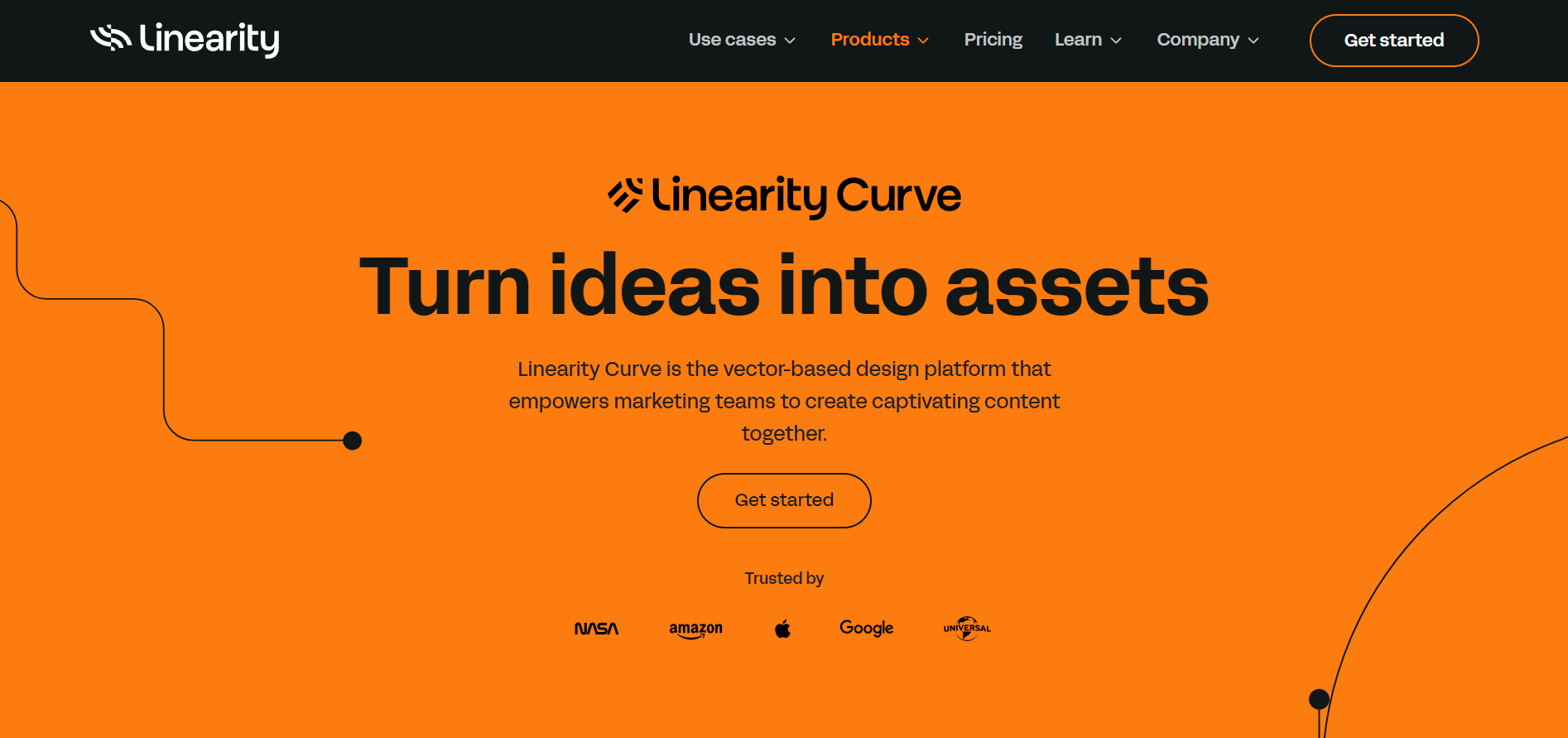
Best for: Intuitive design workflows
Linearity Curve is a comprehensive solution for all your vector graphic design needs. With this design platform, you can easily create, edit, and share impactful visuals.
Looking to drive engagement on your website, product pages, or social media profiles? Linearity Curve offers advanced features specifically designed to streamline your workflow.
You can access a comprehensive library of customizable templates from within the platform and import design files made with third-party software like Adobe Illustrator.
Vectornator is Now Linearity Curve
Your favorite design tool has evolved! Discover the new name and look with the same powerful features you love.
If you're bogged down with repetitive design tasks, you'll appreciate the platform's AI-powered tools to automate some of the tedious aspects of design.
Whether your project involves illustration, social media graphics, packaging, printed materials, or business cards, Linearity Curve equips you with the tools to bring your vision to life.
Canva
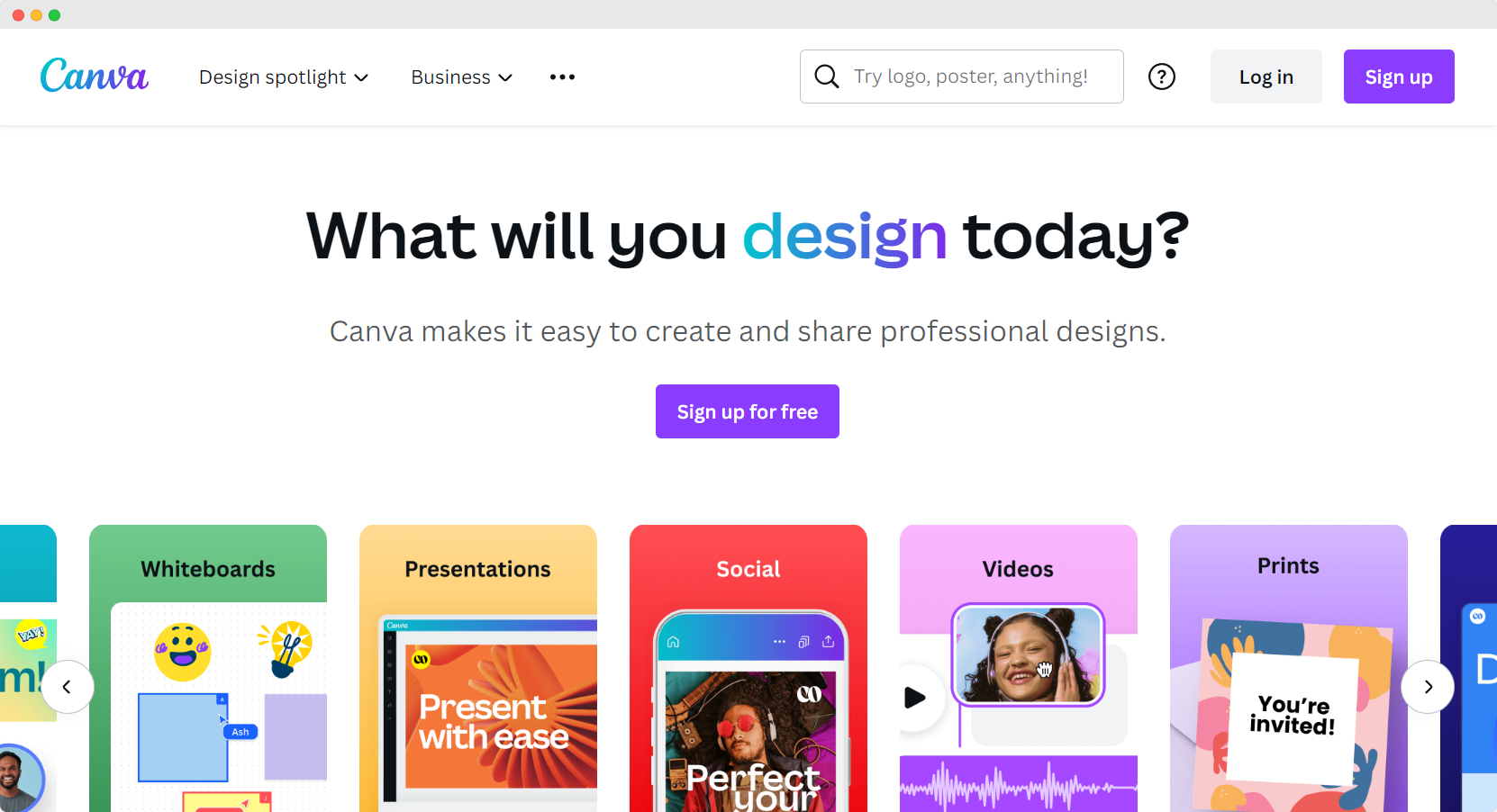
Best for: Quick, template-based designs
This widely used design platform has various features that help automate marketing design tasks, making the creative process more efficient for marketers and graphic designers.
Canva offers a library of pre-designed templates that can be customized for different marketing needs. You can also set up a brand kit that contains all your essential brand elements—logos, color schemes, and fonts.
The Content Planner feature allows you to schedule social media posts from within the platform. You can also automatically resize a design to fit different platform dimensions, saving you the manual effort of adjusting dimensions for each channel.
Adobe Campaign
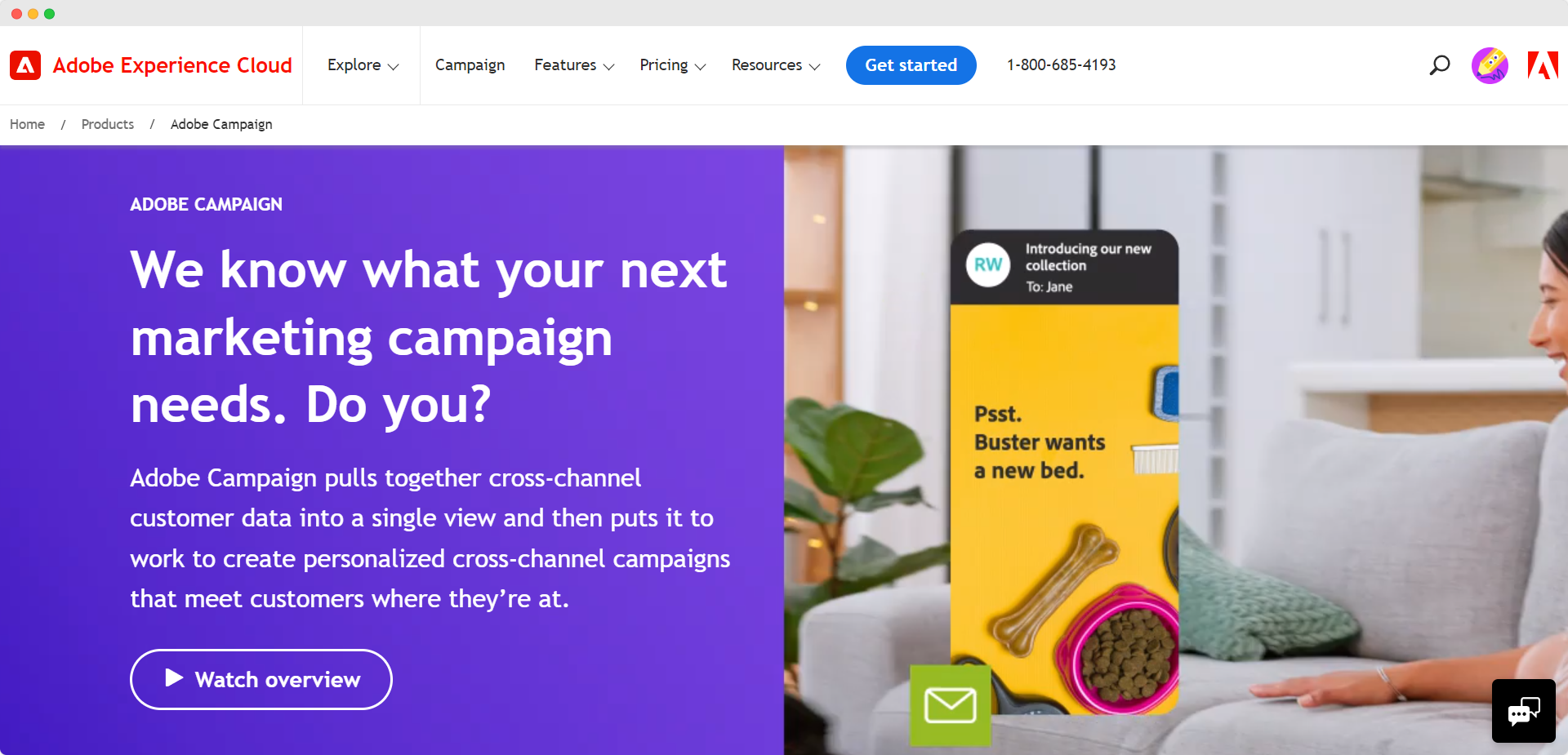
Best for: Email campaigns and mobile marketing
In addition to Illustrator, Photoshop, Premiere Pro, and InDesign, Adobe Campaign is useful for savvy marketers. It allows you to harness customer profiles to plan and deliver effective marketing campaigns and track the entire customer journey.
Adobe Campaign lets you plan and personalize each touchpoint to convert and retain customers. You can combine images, videos, and text with powerful AI tools to deliver the right messages at the most opportune moments.
By leveraging these design platforms, marketers and designers can significantly cut down on repetitive tasks and free up time to focus on the more strategic elements of their campaigns. It's not just about making design accessible; it's about automating processes to achieve more, faster.
Communication software
Clear and consistent communication within your marketing team is essential. You also need to keep open communication channels with your customers. Think Slack, Zoom, and Google Meet.
Slite

Best for: Internal communication and collaboration
Slite is an all-in-one platform that covers all of your communication bases. Use it for a range of marketing tasks:
- Manage and track projects
- Collaborate on brainstorms and documents
- Share files
- Create content calendars
- Chat with coworkers
Its intuitive design lets you stay in constant contact with your team and gives you a traceable overview of internal processes.
Nifty

Best for: Project management
This workflow manager lets you easily collaborate on tasks and track work processes. It can serve as a comprehensive site to organize multiple projects and team members in one place.
You can personalize the display settings to suit your needs and work style. It enables you to track working time, achieve transparency, and improve productivity.
Troop Messenger

Best for: Connecting other communication apps on one platform
Troop Messenger is a communication platform with all sorts of functionalities like video calling, instant messaging, group chats, file sharing, and screen sharing.
No more endless switching between Zoom, Teams, WhatsApp, and Slack—use Troop Messenger can centralize your communication avenues to save valuable time and make your processes more efficient.
Efficient project management starts with effective communication tools. Choose the right tools for your team's processes and leverage automation to improve collaboration with all your stakeholders.
Email workflows
Reaching customers through email campaigns and newsletters is a vital part of any content marketing strategy. Automated communication is also the preferred delivery method for outreach campaigns, gated content, transactional email, and the customer onboarding process.
These applications will help you improve your email design with customizable templates, drag-and-drop features, and helpful audience behavior analytics. You can also manage your email lists and offer personalized content from brands that you work with.
Mailchimp
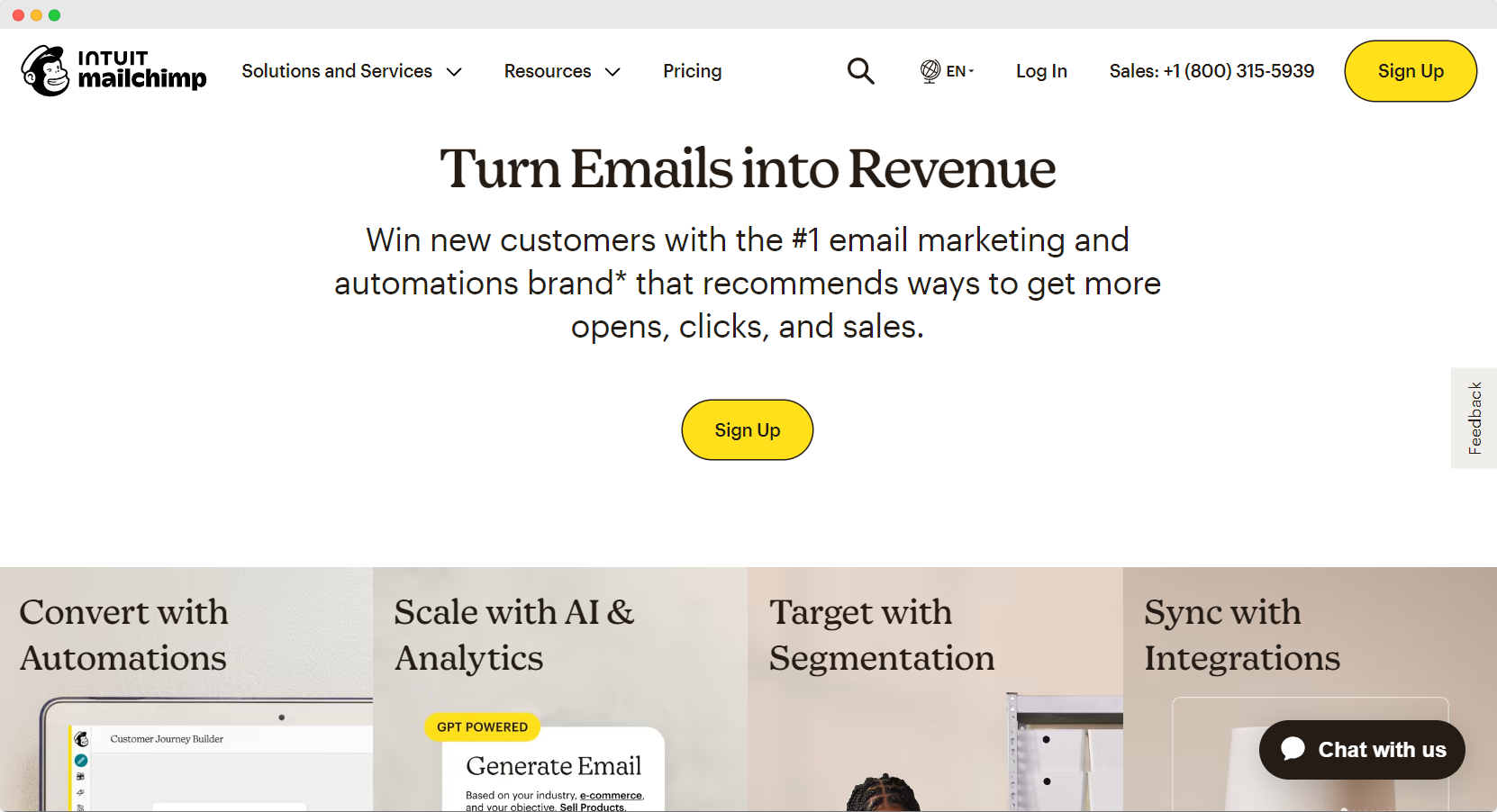
Best for: Setting a different type of email workflow for each stage in the customer lifecycle
Mailchimp is an integrated marketing platform that streamlines email and ad campaign creation, distribution, and analysis. Beyond automating newsletters and pop-ups on your website, it offers a robust email marketing suite with customizable forms and email templates.
The platform has recently rolled out CRM functionalities, making it a powerhouse for marketing pros. You don't need separate software to handle contacts gained from your digital campaigns. Plus, its in-depth analytics simplifies tracking your marketing success.
CleverReach

Best for: Integrated ecommerce, CRM, and CMS workflow for customer communication
CleverReach is a marketing tool for businesses to manage emails and newsletters. The platform offers custom-coded and pre-built email templates and management software. It lets you organize email recipients, implement newsletter tagging, and analyze conversion rates.
You can integrate your emails with external ecommerce systems, CRM platforms, and Content Management Software (CMS).
Constant Contact

Best for: To grow your segmented lists and drive user engagement
With a focus on establishing meaningful audience interaction, Constant Contact helps you create outstanding email campaigns that drive customer engagement.
Its tiered plans include access to email templates, integration with list-growth tools using Google marketing platforms, dynamic content personalization, and other customer personalization at scale.
Marketing automation workflow examples
It's easier to understand the potential of marketing automation through real-world scenarios.
For instance, automating welcome emails can help you engage new subscribers immediately. Implementing lead scoring can prioritize high-value leads, making your marketing efforts more targeted and effective.
Let's look at four typical examples of using automation to improve your marketing workflows.
1. Welcome email sequence
A welcome email series is one of the simplest yet most effective marketing automation workflows. When someone signs up for your newsletter or makes a purchase on your website, they can automatically receive a sequence of onboarding emails.
- Email 1: A warm welcome message to your new email subscriber introducing your brand and thanking them for joining.
- Email 2: An overview of what they can expect regarding your brand's content, deals, or updates.
- Email 3: A special offer or exclusive piece of content to incentivize them to engage more with your brand.
This workflow helps engage your audience from the get-go, providing them with valuable information and incentives to interact with your brand.
2. Cart abandonment recovery
Shopping cart abandonment is a pressing issue for many ecommerce brands. An automated workflow can be set up to target users who added items to their cart but didn't complete the purchase.
- Email 1: Sent within an hour of abandonment, this initial email can gently nudge them to complete their purchase.
- Email 2: A reminder email can be sent one day later, offering a limited-time discount to entice them to complete the purchase.
- Email 3: Sent 48 hours later, this mail can show similar products they might be interested in if the original items weren't quite right.
- Email 4: The last email of the sequence should inform the customer that the items in their cart will no longer be reserved for purchase.
These automated messages can significantly boost conversion rates and add a personal touch to the customer’s shopping experience.
3. Lead nurturing for webinar attendees
If you host webinars, a post-webinar lead nurturing workflow can help turn attendees into customers.
- Email 1: A thank-you email sent immediately post-webinar, along with a recording or summary of the event.
- Email 2: Sent a few days later, this can be a more educational email offering additional resources on the webinar topic.
- Email 3: Finally, an email providing a special offer or exclusive access to a product or service related to the webinar topic.
This series can help you move webinar attendees down the sales funnel, turning interest into action.
4. Product purchase email sequence
Once someone has purchased your product or service, it's vital to retain their attention at this customer journey stage. One of the best ways to do this is to provide excellent customer service.
- Email 1: Order confirmation with product details. Provide the customer with your contact details should they wish to update their account or ask questions.
- Email 2: Delivery update and any other information the customer may be interested in, such as promotions on relevant products.
- Email 3: After the product has been delivered, an email can be sent to confirm delivery and thank the customer for their business. You can also request a customer review.
- Email 4: Consider sending a re-engagement email to get the customer interested in additional products if they had a positive customer experience.
By setting up such automated workflows, you make your marketing operations more efficient and offer your audience a personalized, engaging experience.
Next steps: building your marketing automation workflow
Building a marketing automation workflow involves several key steps, starting with developing a clear strategy.
A well-defined strategy outlines the workflow's goals, target audience, and desired outcomes, ensuring that it aligns with the overall marketing objectives. It also enables the marketing team to determine the specific actions and behaviors they want to track and automate.
Utilizing tools, apps, and integrations that support marketing automation workflows is essential. A robust marketing automation platform provides the necessary features and functionalities to execute automation effectively. This includes tools for email campaigns, lead scoring, follow-ups, analytics, and reporting.
Integrations with other marketing tools and apps, such as CRM systems and social media platforms, can further enhance the capabilities of the workflow.
Building your marketing automation workflow involves strategy development, utilization of tools and apps, and integration with other marketing systems. By implementing automated workflows, your company can streamline its marketing activities, enhance customer engagement, and increase revenue.
When designing marketing assets, Linearity Curve can be your go-to platform, offering helpful automations for efficient creative work. Get started with a free account by signing up below.
Jumpstart your ideas with Linearity Curve
Take your designs to the next level.
![Design the perfect marketing automation workflow [with examples] | Linearity](https://www.linearity.io/blog/content/images/2023/07/repeating-patterns.widget.png)
![Design the perfect marketing automation workflow [with examples] | Linearity](https://www.linearity.io/blog/content/images/2023/11/marketing-automation-workflow.thumbnail.png)
Share this!
Sharné McDonald
Sharné is a contributing writer to the Linearity Blog. She has 10+ years' experience in graphic design and marketing and holds a Master's degree in Art Education.


:quality(75))
:quality(75))



:quality(75))
![Design the perfect marketing automation workflow [with examples] | Linearity](/blog/content/images/size/w1280/2023/07/marketing-software-NewBlogCover.png)


